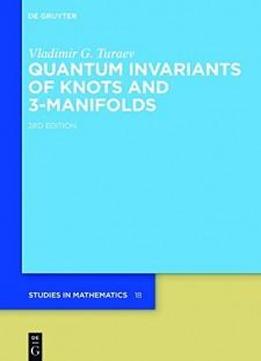
Quantum Invariants Of Knots And 3-manifolds (de Gruyter Studies In Mathematics)
by Vladimir G Turaev /
2016 / English / PDF
3.2 MB Download
Due to the strong appeal and wide use of this monograph, it is
now available in its third revised edition. The monograph gives a
systematic treatment of 3-dimensional topological quantum field
theories (TQFTs) based on the work of the author with N.
Reshetikhin and O. Viro. This subject was inspired by the
discovery of the Jones polynomial of knots and the
Witten-Chern-Simons field theory. On the algebraic side, the
study of 3-dimensional TQFTs has been influenced by the theory of
braided categories and the theory of quantum groups.
Due to the strong appeal and wide use of this monograph, it is
now available in its third revised edition. The monograph gives a
systematic treatment of 3-dimensional topological quantum field
theories (TQFTs) based on the work of the author with N.
Reshetikhin and O. Viro. This subject was inspired by the
discovery of the Jones polynomial of knots and the
Witten-Chern-Simons field theory. On the algebraic side, the
study of 3-dimensional TQFTs has been influenced by the theory of
braided categories and the theory of quantum groups.
The book is divided into three parts. Part I presents a
construction of 3-dimensional TQFTs and 2-dimensional modular
functors from so-called modular categories. This gives a vast
class of knot invariants and 3-manifold invariants as well as a
class of linear representations of the mapping class groups of
surfaces. In Part II the technique of 6j-symbols is used to
define state sum invariants of 3-manifolds. Their relation to the
TQFTs constructed in Part I is established via the theory of
shadows. Part III provides constructions of modular categories,
based on quantum groups and skein modules of tangles in the
3-space.
The book is divided into three parts. Part I presents a
construction of 3-dimensional TQFTs and 2-dimensional modular
functors from so-called modular categories. This gives a vast
class of knot invariants and 3-manifold invariants as well as a
class of linear representations of the mapping class groups of
surfaces. In Part II the technique of 6j-symbols is used to
define state sum invariants of 3-manifolds. Their relation to the
TQFTs constructed in Part I is established via the theory of
shadows. Part III provides constructions of modular categories,
based on quantum groups and skein modules of tangles in the
3-space.
This fundamental contribution to topological quantum field theory
is accessible to graduate students in mathematics and physics
with knowledge of basic algebra and topology. It is an
indispensable source for everyone who wishes to enter the
forefront of this fascinating area at the borderline of
mathematics and physics.
This fundamental contribution to topological quantum field theory
is accessible to graduate students in mathematics and physics
with knowledge of basic algebra and topology. It is an
indispensable source for everyone who wishes to enter the
forefront of this fascinating area at the borderline of
mathematics and physics.Contents:
Contents:
Invariants of graphs in Euclidean 3-space and of closed
3-manifolds
Invariants of graphs in Euclidean 3-space and of closed
3-manifolds
Foundations of topological quantum field theory
Foundations of topological quantum field theory
Three-dimensional topological quantum field theory
Three-dimensional topological quantum field theory
Two-dimensional modular functors
Two-dimensional modular functors
6j-symbols
6j-symbols
Simplicial state sums on 3-manifolds
Simplicial state sums on 3-manifolds
Shadows of manifolds and state sums on shadows
Shadows of manifolds and state sums on shadows
Constructions of modular categories
Constructions of modular categories











